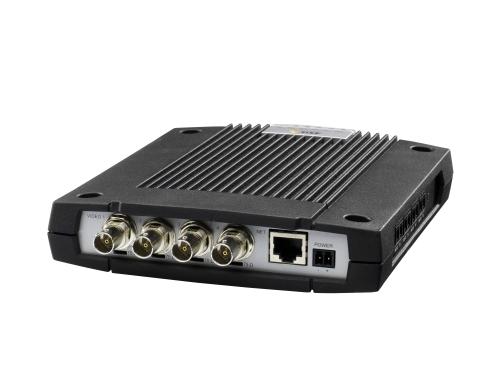 Video servers, sometimes known as video encoders, bridge the gap between analog CCTV surveillance systems and digital IP based systems. Video servers are a great budget conscious, transitional product for those who are looking to gain some of the features and benefits of network based solutions but, aren’t ready to make the full jump.
Video servers, sometimes known as video encoders, bridge the gap between analog CCTV surveillance systems and digital IP based systems. Video servers are a great budget conscious, transitional product for those who are looking to gain some of the features and benefits of network based solutions but, aren’t ready to make the full jump.
If you’ve installed analog cameras in the past few years they’re going to be functional for quite some time. There’s no need to shortchange that investment. Video servers will allow you to maintain those analog CCTV cameras while enhancing your video surveillance system to provide the benefits of IP video.
Why Use A Video Server?
So you don’t have to discard your existing analog cameras! A video server allows your functioning analog CCTV video surveillance system to be integrated with a network video system. Gain the benefits of network video without having to replace what’s bought, paid for, and still working.
Coax Cable Is Expensive
Installing coaxial cable is expensive and once installed, hard to justify re-cabling with Cat 5. And with the average lifespan of an analog camera at 5 – 7 years, what fails first are the VCR’s and DVR’s used to record the video. Video servers not only allow you to keep existing analog equipment such as analog CCTV cameras and coaxial cabling but open up a true network video system because the video is consistently sent over an IP network.
A video server connects to an analog video camera via a coaxial cable and converts analog video signals into digital video streams that are then sent over a wired or wireless IP-based network (i.g., LAN, WLAN or Internet).
Video Server Advantages
- Use of standard network and PC server hardware for video recording and management instead of DVR’s or VCR’s
- Scalability in steps of one camera at a time
- Possibility to record off site
- Ability to remotely access and control analog cameras over an IP network
- Future-proof because the system is expanded easily by incorporating IP cameras
Video Server Components
- Analog Video Input: For connecting analog camera using coaxial cable.
- Processor: For running encoder’s operating system, networking & security functions, encoding analog video using various compression formats, and video analysis. The processor determines the performance of a video encoder measured in frames per second (FPS).
- Memory: For storing firmware (computer program) using Flash, and for buffering of video sequences (using RAM).
- Ethernet/Power over Ethernet Port: To connect to IP network for sending and receiving data, and for powering the unit and the attached camera if Power over Ethernet (PoE) is supported.
- Input/Output (I/O) Connectors: For connecting external devices such as sensors, relays, and lights.
- Audio In: For connecting a microphone or line-in equipment and audio out for connecting to speakers.
What To Consider When Choosing A Video Server
- The number of supported analog channels
- Image quality
- Compression formats
- Resolution
- Frame rate & features such as pan/tilt/zoom support
- Audio
- Event management
- Intelligent video
- Power over Ethernet (PoE)
- Security Functionalities
IP Convergence
Video servers are a great problem solver when you’re faced with the challenge of migrating a large investment in analog CCTV cameras to IP video. Next up I’ll go into more detail about a very important benefit that video servers provide – Event management and intelligent video capabilities with the ability to use advanced video monitoring software.

Pingback: Video Servers and Intelligent Video Surveillance — IP Camera Supply Blog
Pingback: How Video Servers Trigger Alerts and Devices — IP Camera Supply Blog
CCTV Camera Suppliers
Nice blog post to aware people’s about CCTV surveillance systems. In today’s world, its too necessary for anyone’s security. So keep it up !